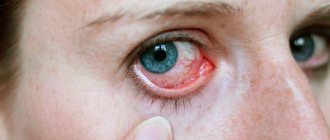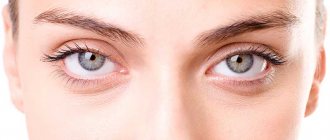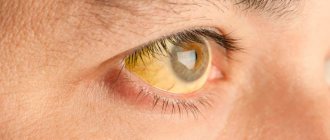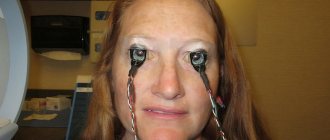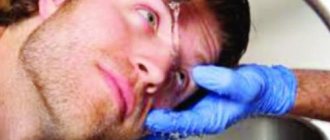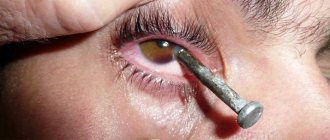Eye burn from alkali – This is one of the most dangerous types of eye injuries that can occur. If alkali gets into the eyes, a chemical burn occurs.
When alkali gets on the mucous membrane of the eyes or on the skin, both around the eyes and on other parts of the body, severe tissue damage occurs, followed by penetration of the reagent into the deeper layers of the mucous membrane or skin. The degree of damage depends on the time of exposure to alkali. The alkaline reagent instantly, in a few minutes, penetrates into the anterior and posterior chambers of the eye through the cornea, the cornea and iris are injured, the outflow of intraocular fluid is disrupted, and the lens is damaged.
In other words, the damaging effect affects almost all structures of the eye. The proteins dissolve, the damage goes both inward and outward. With an alkali burn, the pain is less pronounced than with an acid burn, but do not underestimate the extent of the damage. It is difficult to remove alkali that has penetrated deeply; the effect takes longer and can last up to several days; the degree of damage is determined after the burn.
In case of burns with alkali, the injury can be domestic or industrial. The most dangerous injury from an alkaline reagent occurs in production conditions, since highly concentrated solutions and toxic substances are used in enterprises or factories; such an injury can have very negative consequences for a person. If an alkaline reagent gets on the mucous membrane of the eyes, on the skin around the eyes, timely assistance is an important step, otherwise the person may lose vision forever.
Therefore, it is important for enterprises to observe safety precautions when working with toxic and highly concentrated substances. With regard to a domestic injury, everything is a little simpler, but this does not make it any less dangerous. The consequences of an injury at home are milder than at work, since in everyday life a person deals with a certain and, in most cases, permissible concentration of substances. But, despite this, a chemical burn of the eye caused by alkali at home is also extremely dangerous and can lead to loss of vision, therefore, if alkali gets into the eyes, you should immediately seek help from a specialized institution.
You may be interested in Presbyopia: causes and treatment
Eye burns from acids and alkalis are severe, difficult to treat and, as a rule, treatment is very long and not without consequences. Emergency assistance for an eye burn with alkali should follow within minutes, even seconds after the injury, and after first aid has been provided, an ambulance should be called. But after an ambulance has already been called, it is necessary to continue providing emergency care. It is precisely this point that we will pay attention to in this article, so that, God forbid, of course, you encounter such a case, you know what needs to be done.
The main reasons for getting alkali into the eyes
All causes of eye damage from alkali can be divided into two groups:
- Domestic injuries.
- Industrial injuries.
When eyes are damaged at home, the “culprit” most often becomes household chemicals, namely cleaning products for kitchen stoves, sinks, bathtubs and toilets, especially preparations for breaking through household blockages in pipes.
The reason for this is simple negligence and reluctance to use personal protective equipment such as rubber gloves and special goggles.
Accidents occur less frequently during repairs - burns from lime, whitewash solutions, plaster, and various alkaline-based dyes.
In production, highly concentrated solutions of alkaline preparations can be used, most often the cause of injuries is caustic soda, or lye and other hazardous substances. If drugs come into contact with the skin, mucous membranes or eyes, the victim must be provided with immediate first aid, otherwise the consequences may be disastrous for human health.
Reasons and factors
A chemical burn of the eye is damage to the visual tissues by a chemical substance. Any part of it can be affected. Chemical burns of the conjunctiva and cornea of the eye often occur.
The development of a chemical burn occurs due to penetration of a chemical substance onto the surface of the eye. Among the risk factors are the following:
- Careless handling of household chemicals and medications.
- Cosmetic procedures, for example, a burn to the mucous membrane of the eye that occurs after eyelash extensions. The chemical reagent in this case is eyelash glue, which is applied close to the mucous membrane.
- Construction work, professions involving the use of chemicals, especially without safety glasses.
- Manipulating a car battery that contains sulfuric acid. If handled carelessly, contact with it can result in severe eye burns from concentrated acid.
- Alcohol intoxication, contact of alcohol with the eyes.
First aid for alkaline burns
Emergency care for eye burns from alkali is provided immediately, since the chemical must be neutralized as quickly as possible. The antagonist of alkali is an acid, so the least dangerous agent for them is used to wash the eyes - a solution of boric acid.
The procedure for providing first aid for alkaline burns is as follows:
- Carefully remove any chemical residue from the eyelids and surrounding skin.
- Rinse eyes with clean water to remove traces of alkali. You can use a gauze pad, a piece of cotton wool or a bandage. In case of extensive damage, jet rinsing from a glass or any other container is permissible. The eyes must be open. It is important to wash out all the lye, so it is recommended to rinse for up to a quarter of an hour.
- Neutralize the remaining alkali by washing with a 2% boric acid solution.
- Apply a dry, sterile bandage to your eyes.
- Since eye lesions cause very severe pain, it is recommended to give the victim a painkiller.
While one person strives to rinse the victim’s eyes from the alkali as quickly as possible, the other should immediately call an ambulance, explaining to the operator what exactly happened and what part of the body was injured.
It is also necessary to provide low lighting in the room where the patient is, since severe photophobia develops when the eyes are damaged.
If you don’t have boric acid at hand, you can simply rinse with clean water, saline solution, Ringer’s solution, or even regular milk. It is important to do this as quickly and efficiently as possible, since the alkali remaining in the eye will continue to corrode the mucous membranes and cornea, causing deep damage.
↑ Thermal and thermochemical burns of the eyes
Thermal
(a consequence of exposure of tissue to high air temperature, molten metal, steam, boiling water and fat, flame) and thermochemical eye burns (a consequence of exposure to phosphorus, napalm, incendiary and flammable mixtures) are rarely isolated.
More often they are combined with extensive burns of the face and other parts of the body. Light burns
are characterized by hyperemia and swelling of the affected area of the skin of the eyelids, sometimes the eyelashes and eyebrows are affected.
Conjunctival injection of the eye and the formation of corneal erosions are observed. Moderate burns
are characterized by the appearance of epidermal blisters on the hyperemic and swollen skin of the eyelids.
The conjunctiva is hyperemic and edematous, in the cornea there are defects in the epithelium and superficial layers of the stroma, which are clearly visible when stained with a 1% fluorescein solution. Severe burns
are characterized by extensive damage to the facial skin, conjunctiva, cornea and sclera. The affected areas have the appearance of dark gray scabs.
Ambulance and emergency care.
Remains of the substance that caused the burn should be carefully removed from the skin of the face, eyelids, eyelashes and mucous membranes of the eyes with tweezers or a stream of water. In case of thermal burn of the eyes, rinse the conjunctival sac with water and add 0.3% leocaine solution, 3% trimecaine solution, 0.25% dicaine solution, 20% sulfapyridazine sodium solution, 20% sulfacyl sodium solution, 0.25 chloramphenicol solution, lay for eyelids 10% sulfapyridazine sodium ointment, 10% sulfacyl sodium ointment, 1% tetracycline or erythromycin ointment, 1-5% synthomycin emulsion. If there are blisters on the skin, they must be cut off and the wound surface generously lubricated with the above ointments. An aseptic bandage is applied to the eye. Antitetanus serum (1500-3000 IU) is administered subcutaneously and without delay.
In case of thermochemical burns of the eyes, washing (irrigation) is permissible only in the absence of a simultaneous penetrating injury to the eye.
Remains of the burning substance are removed from the surface of the skin and from the conjunctival cavity
. Then, depending on the degree of damage, the same measures are carried out as for a chemical burn. In cases of phosphorus burns, to neutralize the burn substance, wash with a 0.25-1% solution of copper sulfate.
For such burns, topical use of any eye ointments is contraindicated.
. If a thermal or thermochemical burn of the eyeball and its auxiliary organs is combined with an extensive burn of the face, neck, limbs and other parts of the body, not only local but also general measures are taken to combat pain, shock, and prevent infection. The administration of antitetanus serum (1500-3000 IU) is mandatory. Victims with severe thermal and thermochemical burns of the eyelids and eyes are subject to urgent hospitalization in the eye department, and in case of general burns - in the traumatology (burn) department.
Prevention of eye burns
consists in strict compliance with safety regulations when working in areas of high temperatures, radiant energy, and with “aggressive” liquids. Labor protection provides for a number of collective and individual protection measures.
When working with “aggressive” liquids, it is necessary to use special clothing, which includes glasses or special masks that fit tightly to the skin of the face.
Medical workers are required to be especially careful when using ammonia, iodine solutions, and silver nitrate solutions when carrying out the prevention of gonoblennorrhea in newborns using the Matveev-Crede method (only 1% silver nitrate solution is used!).
Great care is required when whitewashing premises with lime.
. Working without safety glasses is unacceptable.
Use of medications
If caustic alkali gets into your eye, you should not use various medications and drops on your own without a doctor’s permission, this can be dangerous. After you rinse your eyes to remove traces of the alkaline solution, experienced ophthalmologists begin treatment.
They may prescribe the following medications:
- "Atropine". The purpose of use is to relieve pain and prevent the formation of adhesions due to chemical burns. Instill 1-2 drops three times a day as prescribed by the doctor. The drug should not be used if you are allergic to it, in children under 7 years of age, with high blood pressure, with glaucoma and iris synechia.
- Levomycetin drops. This is a remedy with an antibiotic that will not allow the development of an inflammatory process due to infection. The drug is not prescribed for allergic reactions, kidney and liver failure, or blood problems.
- "Korneregel".
- "Ophtagel".
- "Solcoseryl". Like the two previous drugs, the drug is prescribed to accelerate the healing of the wound surface and restore the function of eye cells. This wonderful remedy must be used without fail, as it will help speed up healing and save the patient from vision-threatening lesions of the cornea, membranes, and eyelids. When instilled, especially at first, an unpleasant pain or tingling may appear, but this is a temporary effect and will soon pass. The patient may also feel cloudiness in the “picture”. This is also normal and will pass quickly. “Solcoseryl” is dripped into the eyes, one drop once a day. For very severe lesions, you can apply drops into the eyes every hour, but this must be given permission by the attending physician.
Drugs for treatment are selected by the attending physician individually, for a specific patient, taking into account the degree of damage and concomitant diseases.
Development mechanism
More than 40% of reagent burns are caused by exposure to alkalis:
- ethanol;
- lime;
- caustic soda;
- ammonia.
Such burns are severe injuries, since alkalis have a solid structure and are not diluted with tears, like acids. Under their influence, cell membranes and entire tissues are destroyed. They seem to melt, which is why such a burn is called wet.
When the nerve tissue melts, the person stops feeling pain. The depth of damage may exceed the zone of contact with the substance. The size of the lesion completes its formation after 3 days.
Another 10% are damage caused by chemical acids:
Under the influence of acid, coagulative necrosis (death) of tissue develops, also known as dry necrosis. Cell proteins are destroyed, fluid decreases, and a scab forms. There may be no changes under the surface of the formed scab, or damage of varying degrees of severity may develop. Subsequently, inflammation joins the injured area.
Contraindications
If you do not know what to do if alkali gets into your eyes, do not try to instill the first drops you find into the victim, this can be very dangerous. It is equally risky to try to wipe off the lye with dry things - a towel, handkerchiefs, especially rubbing the substance on the skin. This can only aggravate the damage and spread the “chemistry” over the skin.
If a piece or drop of whitewash, lime, or plaster gets on your skin or eyes, you must first carefully remove it with some object and then rinse the area. If you don’t do this and immediately start rinsing, the alkaline substance will be spread over a large area and the burn will only increase.
Degree of damage
- In the first degree, the top layer of skin is damaged. Redness, swelling, mild pain. - In the second degree, alkali affects the layers of the dermis. Blisters with liquid are added to the previous signs. - The third degree is characterized by acute pain, the appearance of small and large blisters with cloudy liquid. Adipose tissue is affected. Burns can lead to decreased or loss of vision, it all depends on the area of the damage. Surgery is required. - In the fourth degree, the bone structure is affected. Vision is lost, surgical treatment occurs, and partial recovery is possible.
Preventive actions
In order to avoid dangerous eye injuries, you just need to follow the simplest rules:
- Always wear gloves and safety glasses when using household chemicals, especially when unclogging drains and scrubbing toilets.
- Wash your hands thoroughly with soap after using chemicals.
- Store household alkalis in tightly closed, labeled containers away from children.
- Always use personal protective equipment at the workplace.
- Make a special place in the closet or use a lockable container to store household chemicals.
- Do not use industrial cleaners or other hazardous products for household purposes.
Simple precautions and careful attitude towards your health will protect your eyes from dangerous injuries and chemical damage from alkali.
Symptoms and severity
Symptoms will vary depending on the extent of the damage.
- In the first (mild) degree, the pain syndrome is sharp. All protective properties of the body are activated. Blurred vision, redness, increased lacrimation, and swelling of the eyes are added.
- The second degree (medium) is still amenable to effective treatment. The pain becomes permanent (exception: alkali burn - no pain), blisters form on the surface of the eyelids, vision is greatly reduced, and erosions of the conjunctiva and cornea occur.
- Third (severe) degree. Persistent, severe tissue damage, clouding of the cornea, swelling of the mucous membrane and eyelids occurs.
- The fourth degree is characterized by extreme manifestations of the severity of symptoms. It is difficult to preserve vision with such severe damage. The depth and size of the lesion are large.
Complications and prognosis
Among the dangerous complications are the following:
- ulcer formation;
- scars;
- the appearance of a cataract on the cornea;
- adhesions (adhesions) of the mucous membrane of the eyelid and visual tissues;
- increased intraocular pressure;
- blindness;
- infection.
The prognosis depends on the severity and timely assistance provided. Mild and moderate severity responds well to treatment, visual functions are restored if treatment measures are followed. The third and fourth degrees indicate massive damage that is difficult to completely heal.
Like, leave comments under the article, share your tips. All the best, stay healthy.






